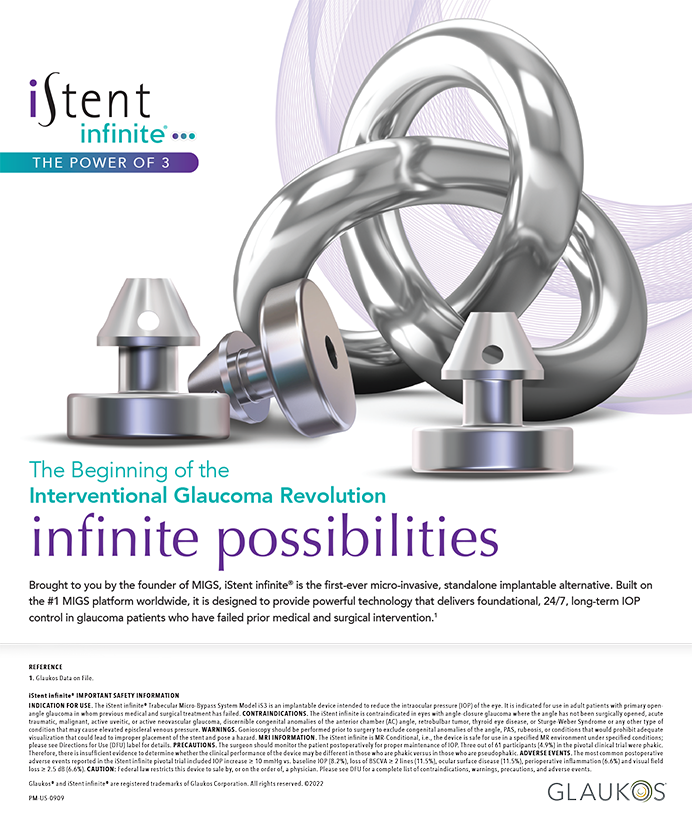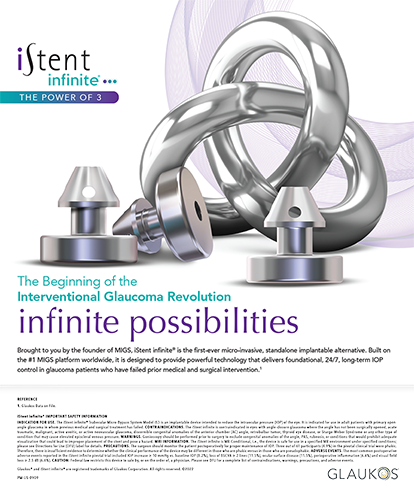Because age contributes to both cataract and glaucoma development, ophthalmologists are often confronted with the challenge of treating both conditions simultaneously. After a thorough history and physical examination, I often elect to perform a combined procedure on patients who require cataract removal and reduction of IOP, merging cataract removal with insertion of the Ex-Press shunt (Optonol, Ltd., Neve Elan, Israel).
Although an increase in IOP in patients with preexisting glaucoma may be short-lived after cataract surgery, it can be difficult to manage and may result in permanent damage to the optic nerve. Because it is not uncommon for cataract patients with preexisting glaucoma to have significant pressure spikes after surgery, simultaneous treatments allow the patient to minimize risk and, generally, to minimize or eliminate the need for postoperative glaucoma medications. Postoperative complications are not significantly more frequent from cataract surgery alone.
SURGICAL TECHNIQUE
Herein, I describe my technique for combined cataract and glaucoma surgery. After completing a temporal clear corneal cataract procedure, the superonasal or superotemporal quadrants are approached. A limbal peritomy, generally 7 mm in cord length, is performed with Wescott scissors. Light hemostasis is achieved with bipolar cautery, and a 30 to 50 partial-thickness scleral flap is outlined with a 15° supersharp blade (Figure 1).
The flap is elevated with a No. 64 Beaver blade (Becton, Dickson, and Company, Franklin Lakes, NJ) and taken out to the clear cornea. An appropriate amount of mitomycin C is applied under the scleral flap as well as posteriorly under Tenon's capsule for 2 to 4 minutes. The area is thoroughly irrigated with balanced salt solution, and a 25- or 27-gauge needle is used create a track—parallel to the iris plane and radially toward the pupillary center—from the posterior blue line into the anterior chamber. The Ex-Press shunt is then placed through the track and engaged into the anterior chamber with a small pop.The device is checked to make sure it is positioned properly, and the scleral flap is closed with one or more 10–0 nylon sutures (Figure 2).
The conjunctiva is then closed with 8–0 Vicryl sutures (Ethicon Inc., Somerville, NJ), and particular care is taken to ensure that the wound is completely watertight. The eye is patched with antibiotic ointment, and a metal shield is placed over the patch.
CASE STUDY
A 64-year-old man previously diagnosed with glaucoma visited our clinic because his referring doctor questioned whether his presenting symptoms were due to progressing cataracts or glaucoma. The patient reported that his vision had gradually deteriorated, especially when driving or looking at small print.
EVALUATION
Initial evaluation revealed a visual acuity of 20/30 OU (visual potential of 20/20 glare acuity of 20/50). The patient's IOP was 24 mm Hg OU, his corneas were clear, and an eight-cut radial keratotomy had been previously performed in both eyes. The anterior chamber was deep and clear, and bilateral 2 nuclear sclerotic and cortical cataracts were present. The cup-to-disc ratio was 0.4 OU with thinning of the inferior rim. Nerve fiber analysis showed a loss of the nerve fiber layer inferiorly in both eyes. His visual fields showed some decrease in sensitivity in the arcuate areas superiorly in both eyes, which were consistent with glaucoma.
His glaucoma was probably inadequately controlled by his current medical management. He had moderate cataracts that were symptomatic and significant. I discussed the risks and benefits of several surgical options with the patient, who elected to undergo bilateral cataract and Ex-Press shunt implantation (Ex-Press P-50), performed approximately 1 month apart.
The patient's postoperative course was uneventful, and his vision returned to 20/20. Postoperative treatment included the use of topical antibiotics for 1 week and frequent topical steroids as well as NSAIDs for approximately 6 weeks. No medication was needed to control IOP. This patient reported minimal discomfort immediately after surgery. His condition progressed well, however, and the long-term results were outstanding. At 3-year follow-up, the Ex-Press shunt and IOL implants were perfectly positioned (Figure 3).
CONCLUSION
Patients who undergo combined procedures are some of my happiest patients and best word-of-mouth referrals. I feel that an integrated procedure for cataract and glaucoma minimizes the additional risk for combined procedures, corrects two problems in one setting, minimizes the risk of postoperative pressure spikes, and provides an excellent visual outcome with minimal astigmatism associated with the glaucoma surgery. There is a 90 probability that IOP will be controlled without medications at 24 months.
Modified and reprinted with permission from Cataract & Refractive Surgery Today Europe's April 2008 edition.
James E. Memmen, MD, is in private practice in Green Bay, Wisconsin. Dr. Memmen states that he receives occasional honoraria for presentations regarding the Ex-Press shunt. He may be reached at jememmenmd@hotmail.com.


